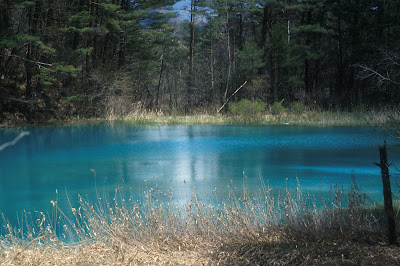Haiku Travels
Mt Bandai (Fukushima)
into the jade-green pond
tumbles a waterfall
and turns into jade
ruri-numa ni/ taki ochi-kitari / ruri to naru
瑠璃沼に滝落ち来たり瑠璃となる
Shuoshi
[Goshiki-numa]
Mt Bandai (Bandaisan) is a stratovolcano located north of the Inawashiro Basin in northern Fukushima prefecture. The active volcano blew its top in recent history: in 1888 an explosion of water vapor caused a collapse of part of the mountain, which resulted in an avalanche of debris. Five villages on the north side of the mountain were buried and 477 people were killed. The explosion also rearranged the landscape by creating the Bandai Kogen plateau and damming local rivers, which formed numerous lakes and ponds. The most famous of these are the so-called Goshiki-numa, or "Five Colored Ponds." Varied in size and shape, each of these ponds, lying between Lake Hibariko and Lake Onogawako, has water of a different color. There is a natural trail that connects the five ponds, with good views of Mt Bandai.
Mizuhara Shuoshi (1892-1981) was a medical doctor and haiku poet. Born in the Kanda ward of Tokyo, he studied medicine at Tokyo University and at a young age showed an interest in haiku. Next to his professional medical activities, he took part in the magazine Hototogisu of Takahama Kyoshi. In 1928, however, he left Takahama's group (which also included, for example, Yamaguchi Seishi) to strike out on his own. Contrary to the "objective description of nature" advocated by Kyoshi, he adopted a more emotional literary style, which he promoted via his own magazine Ashibi. In 1931, he founded the "Shinko haiku movement," which acted as a counter-movement to the Hototogisu magazine. He advocated haiku cycles consisting of several individual haiku and rejected the elimination of seasonal words (kigo). According to haiku historians, Shuoshi brought a new emotional expression to modern haiku.
[Mt Bandai seen from one of the larger lakes in the Goshiki-numa area]
The Goshiki-numa ponds develop various color variations depending on the season and time of day. The one Shuoshi describes has the color of "ruri," or "lapis lazuli." A small cascade falling into the pond sees its transparent water immediately turned into the same color as the pond. As "lapis lazuli" is rather an awkward word in English in a short poem, I have opted for "jade-green" and "jade" in my rendering, which is surely not far from the actual situation as I remember seeing greenish ponds here as well. By the way, this haiku seems to be the "objective description" that Shuoshi had discarded, but perhaps we may look for a deeper meaning: that human beings also tend to conventionally adopt the "color" of the majority... (And "taki," "waterfall," is of course a kigo for summer).
The Goshiki-numa trail runs between Goshiki-numa Iriguchi and Bandai Kogen and takes about an hour. To reach either of the trail ends, there are buses from Inawashiro station. Inawashiro is about 40 min by JR Ban-etsu West Line from Koriyama (a stop on the Tohoku Shinkansen line).Other things to do in the area: you can continue via the JR Ban-etsu West Line to Aizu Wakamatsu, a former castle town with many interesting sights. Or visit the nearby Noguchi Hideo Memorial Museum, dedicated to a prominent bacteriologist who was active on the world stage (10 min by bus from Inawashiro St).
[The photos in this post are my own]


